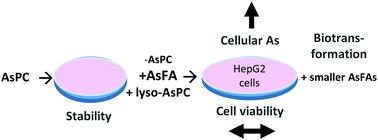当前位置:
X-MOL 学术
›
Metallomics
›
论文详情
Our official English website, www.x-mol.net, welcomes your feedback! (Note: you will need to create a separate account there.)
Toxicological assessment of arsenic-containing phosphatidylcholines in HepG2 cells.
Metallomics ( IF 3.4 ) Pub Date : 2020-05-20 , DOI: 10.1039/d0mt00073f Hannah Finke 1 , Viktoria K Wandt 2 , Franziska Ebert 1 , Nikolaus Guttenberger 3 , Ronald A Glabonjat 3 , Michael Stiboller 4 , Kevin A Francesconi 3 , Georg Raber 3 , Tanja Schwerdtle 2
Metallomics ( IF 3.4 ) Pub Date : 2020-05-20 , DOI: 10.1039/d0mt00073f Hannah Finke 1 , Viktoria K Wandt 2 , Franziska Ebert 1 , Nikolaus Guttenberger 3 , Ronald A Glabonjat 3 , Michael Stiboller 4 , Kevin A Francesconi 3 , Georg Raber 3 , Tanja Schwerdtle 2
Affiliation

|
Arsenolipids include a wide range of organic arsenic species that occur naturally in seafood and thereby contribute to human arsenic exposure. Recently arsenic-containing phosphatidylcholines (AsPCs) were identified in caviar, fish, and algae. In this first toxicological assessment of AsPCs, we investigated the stability of both the oxo- and thioxo-form of an AsPC under experimental conditions, and analyzed cell viability, indicators of genotoxicity and biotransformation in human liver cancer cells (HepG2). Precise toxicity data could not be obtained owing to the low solubility in the cell culture medium of the thioxo-form, and the ease of hydrolysis of the oxo-form, and to a lesser degree the thioxo-form. Hydrolysis resulted amongst others in the respective constituent arsenic-containing fatty acid (AsFA). Incubation of the cells with oxo-AsPC resulted in a toxicity similar to that determined for the hydrolysis product oxo-AsFA alone, and there were no indices for genotoxicity. Furthermore, the oxo-AsPC was readily taken up by the cells resulting in high cellular arsenic concentrations (50 μM incubation: 1112 ± 146 μM As cellular), whereas the thioxo-AsPC was substantially less bioavailable (50 μM incubation: 293 ± 115 μM As cellular). Speciation analysis revealed biotransformation of the AsPCs to a series of AsFAs in the culture medium, and, in the case of the oxo-AsPC, to as yet unidentified arsenic species in cell pellets. The results reveal the difficulty of toxicity studies of AsPCs in vitro, indicate that their toxicity might be largely governed by their arsenic fatty acid content and suggest a multifaceted human metabolism of food derived complex arsenolipids.
中文翻译:

HepG2 细胞中含砷磷脂酰胆碱的毒理学评估。
砷脂包括多种有机砷,它们天然存在于海产品中,从而导致人类接触砷。最近在鱼子酱、鱼和藻类中发现了含砷的磷脂酰胆碱 (AsPC)。在对 AsPC 的首次毒理学评估中,我们研究了 AsPC 在实验条件下的氧代和硫代形式的稳定性,并分析了人肝癌细胞 (HepG2) 中的细胞活力、基因毒性和生物转化指标。由于硫氧型在细胞培养基中的溶解度低,且氧型易于水解,而硫氧型的水解程度较低,因此无法获得准确的毒性数据。水解导致相应的含砷脂肪酸 (AsFA) 成分。细胞与 oxo-AsPC 的温育导致与单独的水解产物 oxo-AsFA 所测定的毒性相似,并且没有遗传毒性指数。此外,oxo-AsPC 很容易被细胞吸收,导致高细胞砷浓度(50 μM 孵育:1112 ± 146 μM As作为蜂窝)。形态分析揭示了 AsPC 生物转化为培养基中的一系列 AsFA,在 oxo-AsPC 的情况下,生物转化为细胞沉淀中尚未鉴定的砷物种。结果揭示了AsPCs毒性研究的难点 oxo-AsPC 很容易被细胞吸收,导致高细胞砷浓度(50 μM 孵育:1112 ± 146 μM As 细胞),而 thioxo-AsPC 的生物利用度低得多(50 μM 孵育:293 ± 115 μM As 细胞) )。形态分析揭示了 AsPC 生物转化为培养基中的一系列 AsFA,在 oxo-AsPC 的情况下,生物转化为细胞沉淀中尚未鉴定的砷物种。结果揭示了AsPCs毒性研究的难点 oxo-AsPC 很容易被细胞吸收,导致高细胞砷浓度(50 μM 孵育:1112 ± 146 μM As 细胞),而 thioxo-AsPC 的生物利用度低得多(50 μM 孵育:293 ± 115 μM As 细胞) )。形态分析揭示了 AsPC 生物转化为培养基中的一系列 AsFA,在 oxo-AsPC 的情况下,生物转化为细胞沉淀中尚未鉴定的砷物种。结果揭示了AsPCs毒性研究的难点 在 oxo-AsPC 的情况下,到细胞颗粒中尚未鉴定的砷物种。结果揭示了AsPCs毒性研究的难点 在 oxo-AsPC 的情况下,到细胞颗粒中尚未鉴定的砷物种。结果揭示了AsPCs毒性研究的难点体外,表明它们的毒性可能主要受其砷脂肪酸含量控制,并表明食物衍生的复合砷脂的多方面人类代谢。
更新日期:2020-07-22
中文翻译:

HepG2 细胞中含砷磷脂酰胆碱的毒理学评估。
砷脂包括多种有机砷,它们天然存在于海产品中,从而导致人类接触砷。最近在鱼子酱、鱼和藻类中发现了含砷的磷脂酰胆碱 (AsPC)。在对 AsPC 的首次毒理学评估中,我们研究了 AsPC 在实验条件下的氧代和硫代形式的稳定性,并分析了人肝癌细胞 (HepG2) 中的细胞活力、基因毒性和生物转化指标。由于硫氧型在细胞培养基中的溶解度低,且氧型易于水解,而硫氧型的水解程度较低,因此无法获得准确的毒性数据。水解导致相应的含砷脂肪酸 (AsFA) 成分。细胞与 oxo-AsPC 的温育导致与单独的水解产物 oxo-AsFA 所测定的毒性相似,并且没有遗传毒性指数。此外,oxo-AsPC 很容易被细胞吸收,导致高细胞砷浓度(50 μM 孵育:1112 ± 146 μM As作为蜂窝)。形态分析揭示了 AsPC 生物转化为培养基中的一系列 AsFA,在 oxo-AsPC 的情况下,生物转化为细胞沉淀中尚未鉴定的砷物种。结果揭示了AsPCs毒性研究的难点 oxo-AsPC 很容易被细胞吸收,导致高细胞砷浓度(50 μM 孵育:1112 ± 146 μM As 细胞),而 thioxo-AsPC 的生物利用度低得多(50 μM 孵育:293 ± 115 μM As 细胞) )。形态分析揭示了 AsPC 生物转化为培养基中的一系列 AsFA,在 oxo-AsPC 的情况下,生物转化为细胞沉淀中尚未鉴定的砷物种。结果揭示了AsPCs毒性研究的难点 oxo-AsPC 很容易被细胞吸收,导致高细胞砷浓度(50 μM 孵育:1112 ± 146 μM As 细胞),而 thioxo-AsPC 的生物利用度低得多(50 μM 孵育:293 ± 115 μM As 细胞) )。形态分析揭示了 AsPC 生物转化为培养基中的一系列 AsFA,在 oxo-AsPC 的情况下,生物转化为细胞沉淀中尚未鉴定的砷物种。结果揭示了AsPCs毒性研究的难点 在 oxo-AsPC 的情况下,到细胞颗粒中尚未鉴定的砷物种。结果揭示了AsPCs毒性研究的难点 在 oxo-AsPC 的情况下,到细胞颗粒中尚未鉴定的砷物种。结果揭示了AsPCs毒性研究的难点体外,表明它们的毒性可能主要受其砷脂肪酸含量控制,并表明食物衍生的复合砷脂的多方面人类代谢。



























 京公网安备 11010802027423号
京公网安备 11010802027423号